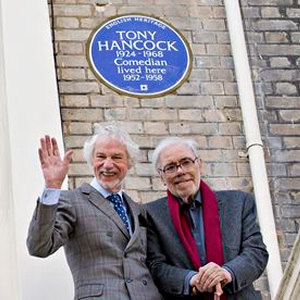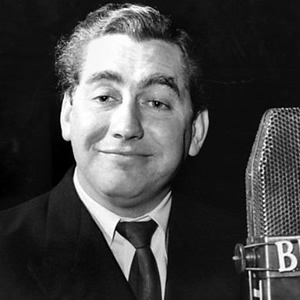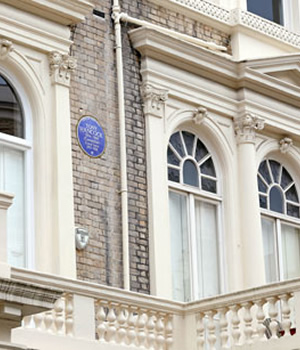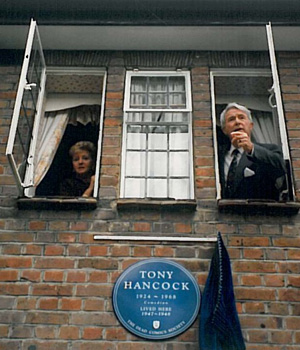Tony Hancock gets blue plaque on 90th birthday

English Heritage have placed a blue plaque to commemorate Tony Hancock.
The comedian, famed for his starring role in ground-breaking radio and television sitcom Hancock's Half Hour, would have been 90 years-old today (12th May 2014).
The plaque was unveiled outside the comic's former home by Ray Galton and Alan Simpson, the writers who shaped his character through many sitcom and radio scripts.
The plaque is situated at 20 Queen's Gate Place, a building near the Natural History Museum in Kensington where Hancock and his wife Cicely owned a flat between 1952 and 1958.
The comedian's co-stars Sid James and Kenneth Williams were amongst the regular visitors to the residence, and it was at this address he mapped out the film The Rebel with Galton & Simpson. English Heritage say: "It was the London address where he lived the longest and his five years there coincided with the most creative, successful and memorable period of his career."
The plaque says "Tony Hancock. 1924 - 1968. Comedian. Lived here 1952-1958." English Heritage's historian Howard Spencer explains: "This blue plaque recognises a colossus of comedy. In the late 1950s and early 1960s, Tony Hancock became one of Britain's first comedy superstars, a radio and television phenomenon, and his influence is still apparent today."

Galton & Simpson say: "Tony Hancock was the comedian's comedian. When we were writing Hancock's Half Hour, he told us, 'You're the writers, you write, I'm the comedian, I'll comede.' And boy, could he comede. We are delighted that English Heritage is celebrating Tony with a plaque. It is a little ironic that a man who steadfastedly refused throughout his career to use any blue material should be remembered with a blue plaque."
Anthony John Hancock was born in Birmingham on 12th May 1924. The son of a semi-professional comedian and entertainer, he was influenced from a young age to pursue a theatrical career. When his family moved to Bournemouth, where his parents ran hotels, Hancock found himself in the midst of a bustling entertainment industry. He left school at 15, and made his stage debut in Bournemouth in 1940.
After four years in the RAF, he moved to London to pursue his ambitions. Hancock played in various theatrical productions around the country, before making his radio debut in Variety Bandbox in January 1948. He then shot to star billing with the popular series Educating Archie, in which he appeared from August 1951.
However, it was with his own series, Hancock's Half Hour, first broadcast on the radio in 1954, that Tony Hancock became a household name. The show lasted for six series on radio, coming to an end in 1959. Meanwhile, the format transferred to TV in July 1956 and became even more popular.

Hancock was living at Queen's Gate Place at the height of the show's popularity. English Heritage say: "Although the stucco exterior of Queen's Gate Place is a million miles from Railway Cuttings in East Cheam, this was not true of its interior.
"Writer Philip Oakes considered the kitchen to be 'a breeding ground for botulism' while Dennis Main Wilson who produced the radio version for most of its run described it as follows: 'There was an old leather club armchair with the stuffing coming out, a few other odd chairs and a put-you-up settee. There was an underfelt on the floor but no carpet. There was a mark where someone had been sick. There were piles of fan letters behind the lavatory pan.'
"The top-floor flat was accessed only by stairs and Hancock regularly appeared at his door panting and out of breath. He would joke 'We knew who our friends were in those days'."
Hancock famously broke away from Galton & Simpson towards the end of his career but failed to achieve similar success in his new ventures. He was known to be a perfectionist, and revealed himself in interviews to be extremely self-critical. After a long battle with alcoholism and a crumbling personal life including the break-up of his second marriage, he committed suicide whilst working in Sydney, Australia, in June 1968.
Tony Hancock is remembered for his significant contribution to British comedy. English Heritage conclude: "Tony Hancock has had an influence on comedy disproportionate to the short length of his career.

"Hancock's Half Hour, featuring his impeccable comic timing and accurate rendering of a character in which everyone could believe, was a phenomenon. It made popular the variety of observational, character-based comedy, which has since been the basis of so much British comedy.
"From Steve Coogan to Paul Merton, many of today's comedians have cited Hancock as an influence."
This is not the first plaque to be dedicated to Hancock. Unveiled by Ernie Wise (pictured), The British Comedy Society dedicated a blue plaque in his honour some 22 years ago, in May 1992, at another former London home of the sitcom star. He lived at 10 Grey Close, NW11 after first moving to London in the late 1940s.
BBC Radio is currently preparing The Missing Hancocks. The show involves the re-recording five missing episodes of the classic radio sitcom using contemporary actors. The series is expected to be broadcast in November.
Below is a clip from The Blood Donor, perhaps the comedian's most famous scene:
